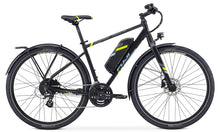
The Fuji Conductor 2.1 Electric Bike is a commuter bike designed to provide the power and convenience of an electric motor while offering outstanding components and performance. With its upright geometry and pedal-assist capabilities, the Fuji Conductor 2.1 Electric Bike aims to keep your daily commute and errands effortless and enjoyable. Let's explore some of its key features and benefits:
 |

|
 |
-
Electric Motor and Pedal Assist: The Fuji Conductor 2.1 Electric bike is equipped with an electric motor that offers pedal assist, meaning it provides assistance to your pedaling efforts. This feature allows you to ride with less effort, especially on inclines or when you need an extra boost. With the electric motor's assistance, you can reach speeds of up to 20 miles per hour, making your commutes faster and more efficient.
-
Commuter-Friendly Design: The Fuji Conductor 2.1 Electric bike is specifically designed for urban commuting. Its upright geometry ensures a comfortable riding position, allowing you to maintain good visibility and posture while navigating city streets. The Fuji Conductor 2.1 Electric bike's frame is typically made from lightweight materials like aluminum or carbon fiber, providing a balance between durability and weight.
-
Power and Range: While specific details may vary, the Fuji Conductor 2.1 Electric bike is designed to offer a suitable balance of power and range. The electric motor provides assistance to make your ride smoother, but the range may depend on factors such as the battery capacity, terrain, and level of pedal assist used. It's recommended to check the manufacturer's specifications for precise details on the bike's power and range capabilities.
-
Quality Components: Fuji bikes are known for their high-quality components, and the Conductor 2.1 is no exception. It likely features reliable brakes, responsive shifting, and a sturdy drivetrain. These components contribute to a smoother and more reliable riding experience, ensuring that your bike performs well in different conditions.
-
Convenient Transportation: With the Fuji Conductor 2.1 Electric bike, commuting and running errands in the city become more convenient. The electric motor's assistance reduces the effort required, enabling you to arrive at your destination quickly and with less fatigue. The Fuji Conductor 2.1 Electric bike may also come with practical features such as integrated lights, fenders to protect from splashes, and a rear rack for carrying cargo or attaching panniers.
-
Environmentally Friendly: Electric bikes are considered eco-friendly transportation options since they produce zero emissions and reduce the reliance on fossil fuels. By choosing the Fuji Conductor 2.1 Electric bike for your daily commuting needs, you contribute to a greener environment and help reduce your carbon footprint.
Remember, the specific details and specifications of the Fuji Conductor 2.1 Electric Bike may vary, and it's recommended to refer to the manufacturer's website or contact Fuji Bikes directly for the most up-to-date and accurate information about this model.
-
Sizes
S (15"), M (17"), L (19") , XL (21") , XXL (23")
Color(s)
Satin Black / Green
Frame
Fuji A2-SL Custom-Butted Alloy, integrated head tube, down tube battery mount, fender and rack mounts
Fork
Fuji A2-SL alloy rigid, forged crown, 700C, 100 x 15mm thru axle
Crankset
Shimano TY-301, 48/38/28T w/ chainring guard
Bottom Bracket
Bafang sealed cartridge BB with cadence sensor
Pedals
Aluminum body, chromoly axle
Front Derailleur
Shimano Tourney TY710
Rear Derailleur
Shimano Altus M310
Shifters
Shimano Altus M310, Rapid Fire
Cassette
Shimano Altus HG31, 11-32T, 8-speed
Chain
KMC X8 w/ Missing Link, EPT anti-rust, 8-speed
Wheelset
Shimano MT400, 15mm thru axle CL disc, 36H, front, Bafang rear motor hub, 6 bolt disc, 36H, stainless steel spokes, Vera Corsa DPD17 aluminum double wall rims
Tires
Vera City Wide 700 x 50c, E Line 50 w/ Phalanx puncture protection, reflective stripe
Brakeset
Shimano MT200 hydraulic disc, rotors: 160mm front, 160mm rear
-
Brake Levers
Shimano MT200 hydraulic 3 finger lever
Headset
1 1/8", Zero Stack, sealed cartridge bearings
Handlebar
Oval Concepts riser bar, 6061 alloy, 15mm rise, 5° sweep, 31.8mm clamp
Stem
Fuji, forged aluminum, +/-6°
Grips
Oval Concepts Comfort Single LO, single density Kraton
Saddle
Oval Sport, steel rail
Seatpost
Oval Concepts OE, 6061 alloy micro adjust, 27.2mm diameter
Fenders
Front & rear 3/4 length, stainless steel hardware
Headlight
Axa Ecoline 15 Lux
Taillight
Herrmans H-Cargo
Rear Carrier
Stealth alloy
Drive Unit
Bafang H400B rear hub motor, 250W rated power, 20mph OR 25kph maximum assist
Battery
Fuji Power Pack 417Wh w/ 2A charger
Display
Bafang 5 mode LED display w/ walk assist
Accessories
Alloy kickstand, bell
 |
 Exploring Electric Bicycles (eBikes): Power, Battery Size, and Maintenance
Electric bicycles, commonly known as eBikes, have gained significant popularity in recent years due to their eco-friendly nature and ability to provide an effortless and enjoyable commuting experience. With various power options and battery sizes available, eBikes offer versatility and convenience to riders of all preferences and needs. In this article, we will delve into the differences between 500, 750, and 1200-watt eBikes, discuss how battery size affects the distance traveled, and highlight essential battery maintenance tips for prolonged lifespan.  Power Matters: 500, 750, and 1200-Watt eBikes eBike power is measured in watts (W), representing the motor's electrical output. The power output directly influences the speed and performance of the eBike. Here's a breakdown of the power options and their impact: 1. 500-Watt eBike: A 500-watt eBike motor provides a decent amount of power, allowing riders to comfortably navigate inclines and maintain a moderate cruising speed. It strikes a balance between efficiency and performance, making it suitable for most urban and suburban commutes. 2. 750-Watt eBike: With a 750-watt motor, riders can expect a substantial boost in power and performance. This higher power output enables faster acceleration, increased torque, and enhanced climbing capabilities, making it suitable for riders who frequently encounter hilly terrains or prefer a more exhilarating riding experience. 3. 1200-Watt eBike: A 1200-watt eBike motor delivers a significant surge of power, catering to riders seeking maximum speed and performance. These high-powered eBikes are designed for off-road adventures, challenging terrains, and riders who desire an adrenaline-fueled ride.  Battery Size and Range: Exploring 10Ah, 16Ah, and 20Ah Batteries The battery size of an eBike plays a crucial role in determining the distance it can travel on a single charge. Battery capacity is measured in ampere-hours (Ah) and represents the total amount of energy the battery can store. Here's how different battery sizes impact the range: 1. 10Ah Battery: A 10Ah battery is considered a standard capacity option, providing a reasonable range for everyday commuting. Depending on factors like terrain, rider weight, and assistance level, an eBike with a 10Ah battery can typically travel between 20 to 40 miles on a single charge. 2. 16Ah Battery: Stepping up to a 16Ah battery offers increased capacity, resulting in an extended range. Riders can expect to cover distances ranging from 40 to 70 miles, depending on the aforementioned factors. The 16Ah battery is ideal for longer commutes or riders who prefer fewer charging intervals. 3. 20Ah Battery: A 20Ah battery represents the highest capacity option available for eBikes. With this larger battery, riders can enjoy a significantly extended range, typically between 60 and 100 miles. eBikes equipped with a 20Ah battery are ideal for long-distance riding, touring, or exploring rural areas where charging points may be scarce.  Battery Maintenance Tips for Longevity To ensure your eBike's battery performs optimally and has a long lifespan, it's essential to follow proper maintenance practices. Here are a few key tips: 1. Avoid Depleting the Battery: It is advisable not to let your eBike's battery drain completely before recharging. Lithium-ion batteries, commonly used in eBikes, tend to degrade faster when discharged completely. Aim to recharge when the battery level reaches around 20-30 |
 |















